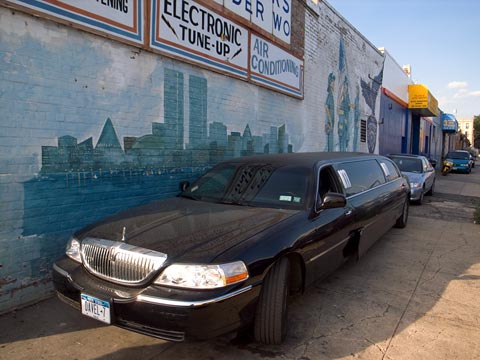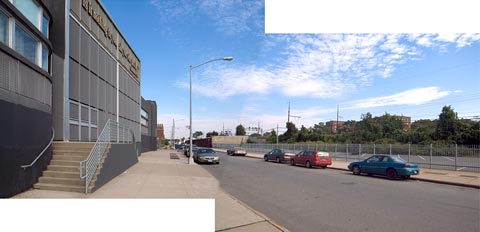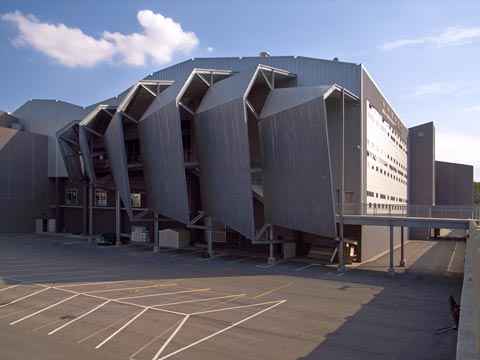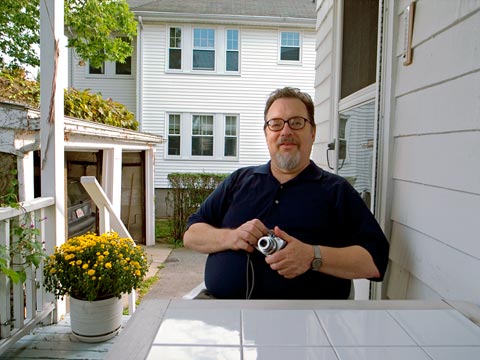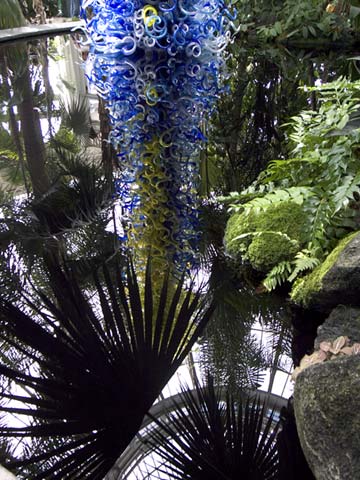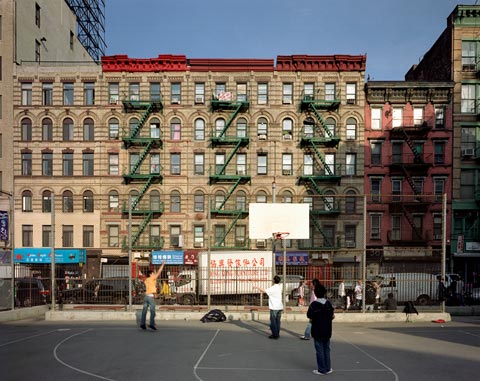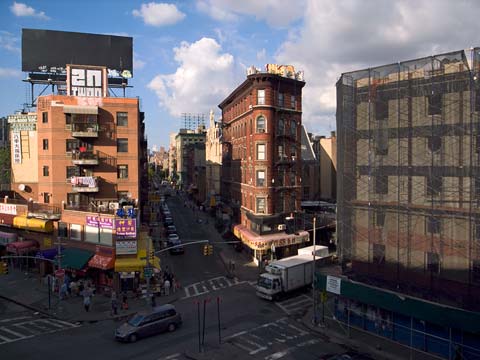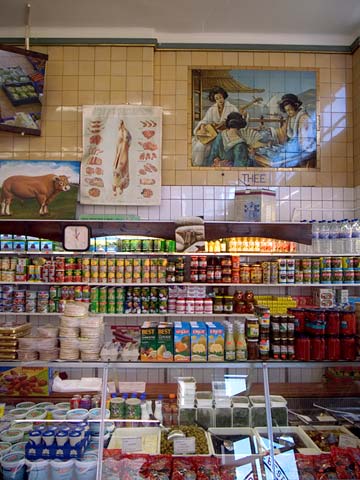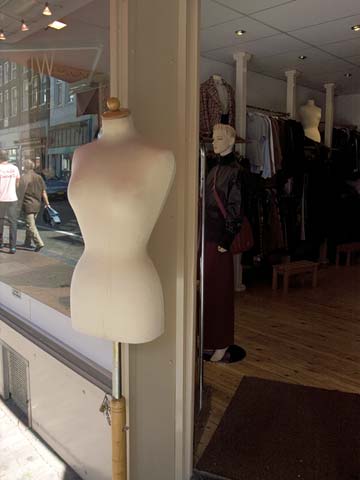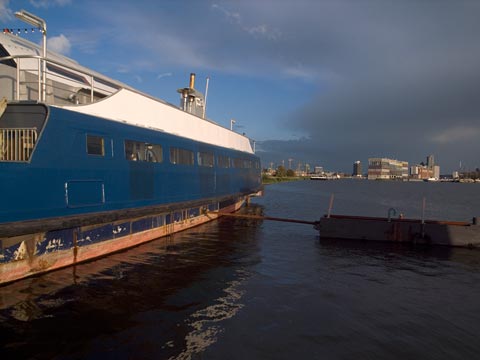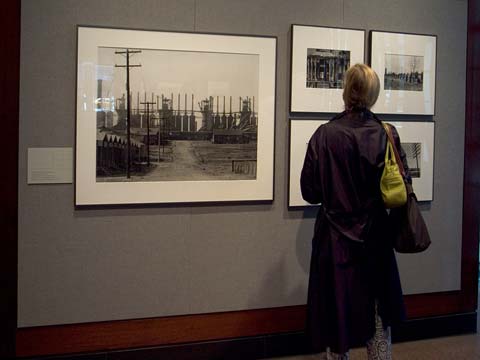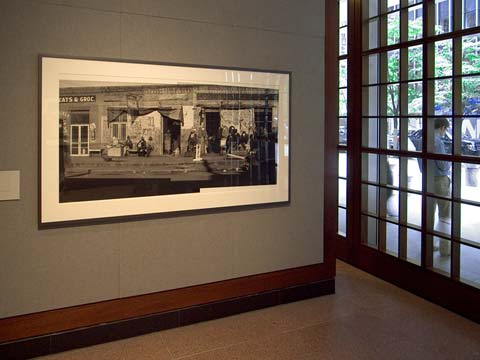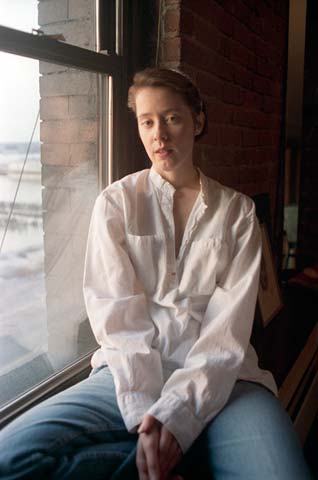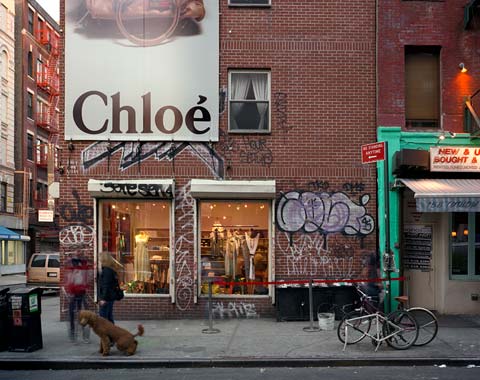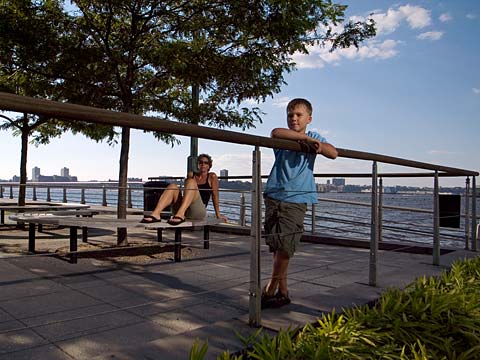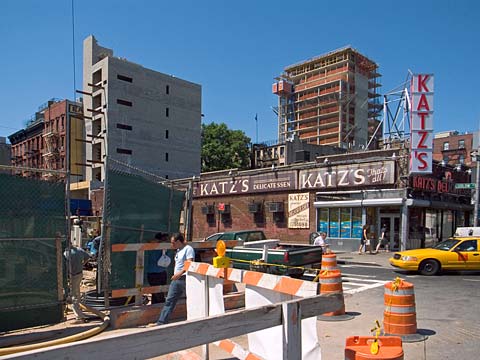Been busy working on a grant proposal about photographing megachurches. See posts below. Today, we joined a protest march against the imprisoning of an illegal alien child awaiting expulsion with his mother from the Netherlands. This is but one of hundreds of cases. Children in jail. The Netherlands. Land of tolerance. Home of the World Court.
Amsterdam

Shells collected by Brendan, my son.
Yesterday the United States Senate led by the Republicans and a few cowardly Democrats betrayed the fundamental values of my country by passing a bill that nullifies the Geneva Conventions even as it says the opposite, unconstitutionally undermines habeas corpus rights, and gives to the President potentially dictatorial powers.
Meanwhile, here in the Netherlands where I am for the moment, an 8 year old sits in a prison cell with his mother, an illegal alien from China, awaiting deportation. The boy was born in the Netherlands, has been educated in the Netherlands, and has lived nowhere else. He has zero rights to residence in the Netherlands. He and his mother will shortly be thrown to the wolves.
New York/Korean Presbyterian Church
Continuing the post of a few days ago, I traveled out to Queens to photograph the Korean Presbyterian Church, a so-called megachurch designed by the noted architect Greg Lynn. Although this building has significant architectural merit (article here), what interests me most is the new religious landscape, the way in which religious expression manifests itself physically in society. This, I hope, will be the first of many such places that I explore with my camera. The pictures posted here are digital snaps made in addition to 4×5 color film.
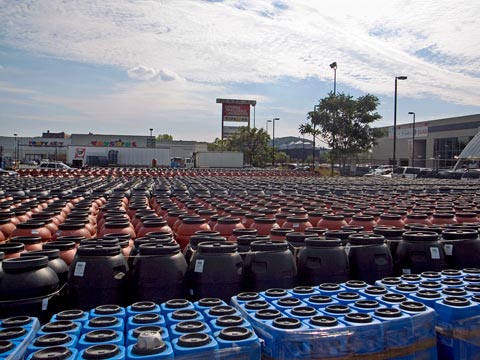
The Korean Presbyterian Church in the distance
Traditional American churches are typically cruciform structures, their steeples punctuating the skyline, and are often located in a prominent spot on a major street or town square. The new churches for reasons economic or social are more likely to be found in peripheral locations convenient to their congregations, usually accessible by automobile. That is as true for this Korean immigrant community in New York City as it is for white suburbanites on the fringes of cities around the U.S.
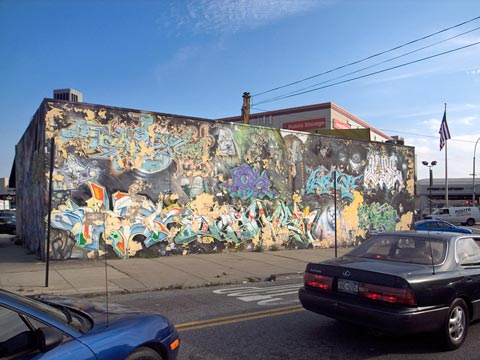
Northern Boulevard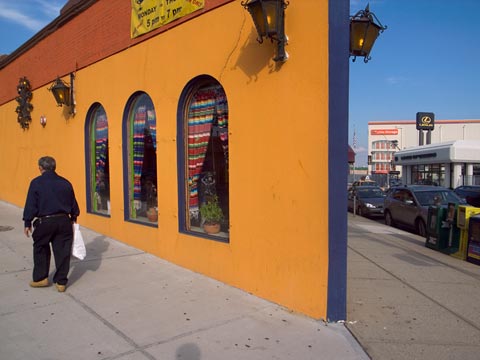
Northern Boulevard
I took the subway to Northern Boulevard, a wide swath of asphalt leading out from the Queensborough Bridge (59th Street Bridge). The church is near the Sunnyside train yards used by the the Long Island Railroad and Amtrak. It’s a hard stretch of streetscape with car dealers, auto body shops, strip malls–as well as a few strip joints–diners, and fast food outlets. The church is located directly adjacent to the rail yard amidst factory buildings and warehouses. An immense new car lot with hundreds of vehicles lies just to the north. Every few minutes a train passes by the church, and the passengers can clearly see the words “is it nothing to you, all you who pass by?” afixed to a metal screen attached to one side of the building. Just out of view on the other side of the rail embankment is Sunnyside Gardens, a historically important planned community, once the home to urban planner and critic Lewis Mumford. (Google Map)
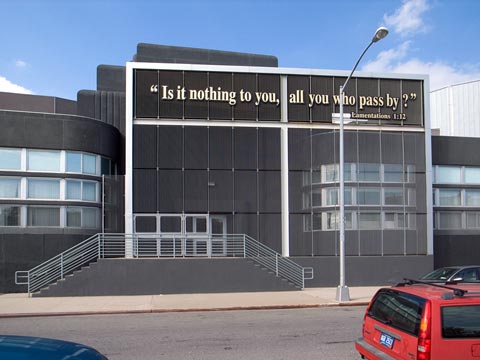
Former entrance to the Knickerbocker Laundry
Greg Lynn’s church building is actually an adaptive reuse of the Knickerbocker Laundry, an art deco factory that stood abandoned for years. The symmetricality of the older building, however, has been disrupted by the new addition, and the former entrance is now covered by the aforementioned steel screen placed off center to the original doors. Despite all that has been done to the original, the strong forms and curves of the deco design remain clearly visible along the street.
The main entrance to the church is through a gateway and faces a huge parking structure, which dominates views of the building from that side. On the north side of the building, a series of nested polygons contains stairs leading from the different levels of the sanctuary. It’s the most striking design element of the whole complex–industrial, angular, mettalic–not the usual stuff of churches. I could easily imagine a jumbo jet parked at the edge of this structure.
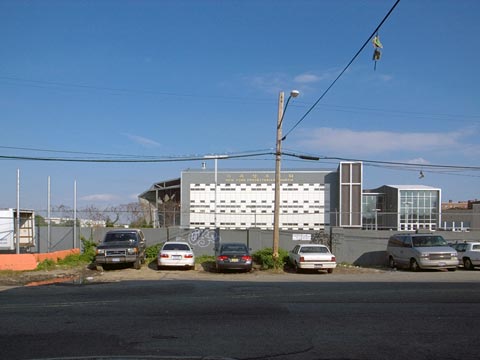
Just outside the church compound
I photographed the building from as many places as I could easily reach. I was there without any special access, and was actually surprised to be able to walk about the compound so freely. I did not seek to go inside, but there are some nice interior views on the Greg Lynn website. I also did a number of shots looking toward the building from some distance away. It’s hard to get a vantage point that explains the setting of the building, but that’s the way it is in this strange somewhat alienating landscape. The only recognizable religious iconography is the abstracted cross formed by white steel beams.
New York/Korean Presbyterian Church
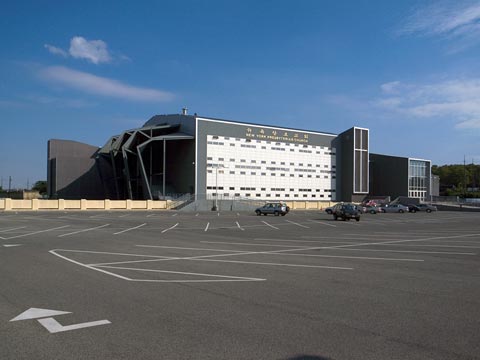
Korean Presbyterian Church, Queens, New York
Looking past the Lower East Side to a new project I’d like to do, I took the subway out to Queens to photograph the Korean Presbyterian Church. For some time, I have been interested in the phenomenon of megachurches and the way in which they are redefining and/or fitting in to the urban landscape–often suburban landscape. I am tentatively calling my project the New Religious Landscape, and while I expect that it will center on megachurches, I am open to other forms of religious architecture or display. The Korean Presbyterian Church is a megachurch, but atypical in that it is in New York City, and that it was designed by an architect very much on the cutting edge, Greg Lynn. More photographs and comments to follow.
Boston
I took the train to Boston to visit Rodger Kingston a photographer, collector, and Walker Evans scholar, among other things. We met online recently after I posted my reactions to the Evans show at the UBS gallery in New York. Rodger is a great conversationalist and generous with his time, and I had a most enjoyable stay, however short. While in Boston I met the staff of the Photographic Resource Center and the photography curators at the Museum of Fine Arts. Unfortunately, I couldn’t spend much time in Rodger’s house in Belmont (near Cambridge) because of my rather severe allergy to cats. I actually picked up a face mask at a nearby hardware store so that I could go inside for at least a little while. Fortunately, however, the weather was unusually balmy for late September, and we were able to sit on the back porch, look at photographs, and talk.

The view from Rodger Kingston’s porch
Rodger showed me some of his cibachrome prints featuring pop art imagery not unlike the iconography of Andy Warhol. One picture prominently displaying a Mao poster was particularly vivid. I showed Rodger work prints of my ongoing Lower East Side project. We also exchanged books–my Lost Border and Rodger’s bibliography on Walker Evans. I took the late train back to New York.
New York/Botanical Garden
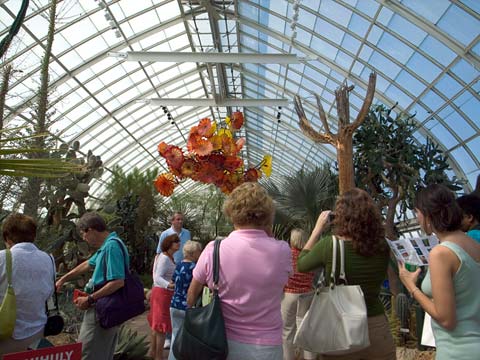
Crowd at the New York Botanical Garden
On Sunday I traveled to the Bronx to see Dale Chihuly’s glass sculptures set among the plants of the New York Botanical Garden. While on the train I read in the Times about Hiroshi Sugimoto’s photographs of Richard Serra’s sculpture Joe, which is situated in the new Pulitzer Foundation for the Arts in St. Louis designed by Japanese architect Tandao Ando. Like much of Sugimoto’s recent work, the photographs are minimal black and white images deliberately made out of focus. Originally, the photographs were to be a collaboration with Serra, but he, evidently, was uncomfortable with the idea, and left Sugimoto to his own devices.
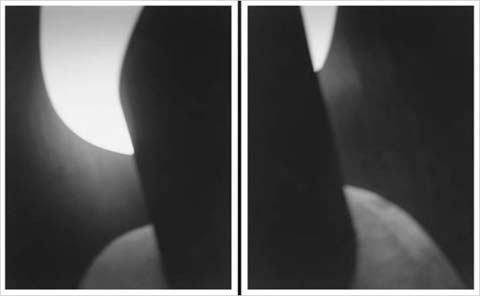
Richard Serra’s sculpture Joe as photographed by Hiroshi Sugimoto
Reducing Serra’s tactile reddish steel sculpture into fuzzy monochrome light and shadow does not compute with my reading of Serra’s work. Ando’s building was designed to contain the spiraling form of Serra’s sculpture–a collaboration between the artist and architect–but nowhere in Sugimoto’s pictures is there any evidence of the surrounding architecture. One could argue that Sugimoto uses Serra entirely to create his own separate reality, linked to the original source, but not intended as a document. Well okay, if you think that transforming Serra’s tough, tightly wound masterpiece into a series of ephemeral two dimensional compositions is a worthwhile project.

Chihuly glass sculpture reflected in water
Thinking of Richard Serra massive steel objects it’s hard to transition to Dale Chihuly’s multi-colored blown glass. Chihuly is the ultimate eye candy, easy to like, and easy to dismiss. As one visitor to the Botantical Garden exclaimed in New Yorkese, it’s gawgeous. You can’t really disagree with that. The installation is a spectacular crowd pleaser. But there are moments of more sublime pleasure like the column of blue and green writhing glass tubes set among palm trees, or the silvery glass spikes hanging amidst grey/green cactuses. Here are some visual impressions of the show.
New York/LES
On Saturday I continued my Lower East Side project walking down Eldridge Street to Chinatown. As usual I used a 4×5 view camera, and snapped similar images with the digital camera. Some are quite close to the 4×5 frame, some not. All the pictures below were taken with my Ricoh GR.
I walked all the way down Eldridge to where it meets Division Street and runs into the massive structure of the Manhattan Bridge. Near the bridge is the newly restored Eldridge Street Synagogue dating back to 1886 when this part of the Lower East Side was largely Jewish. The immediate area is now predominately Chinese, and I am trying to get a photograph of the building that shows the present context. For now, here is a straight architectural view.
The corner of Eldridge and Division is another spot I’ve been trying to do justice to. There’s a small hill where the synagogue stands, and then the space opens out in front of the Manhattan Bridge. There is a cocophany of architectural styles, signage, crowds, outdoor markets, and queues for catching the many cheap buses to Boston. On Saturday I climbed the walkway over the Manhattan Bridge and took several shots with the digital camera. Unfortunately, there is chainlink fencing along the railing making it impossible to get a view camera lens through an opening. Up the bridge there are other possibilities that incorporate the bridge elements themselves. I plan to return a bit earlier in the day. Here is a view of Eldridge and Division from the bridge.
New York/Suzanne Vega
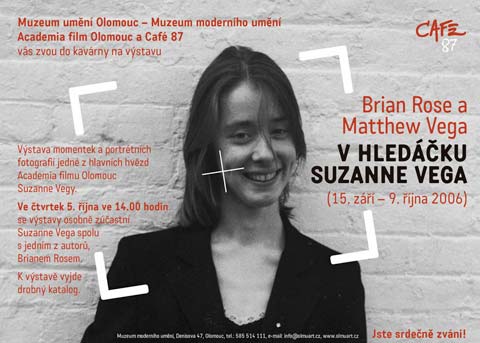
This is the poster for the exhibit I am doing in the Czech Republic of early portraits of Suzanne Vega. I’ve known Suzanne since the late 1970s when I first arrived in New York. Here is a previous post with some of the images in the show.
Amsterdam/New York
Back in New York, an overnight two day shoot of interiors at a golf club in the Hamptons. Then scans, color correcting, and delivery to the client. A busy week. Monday, of course, marked the fifth year since the destruction of the World Trade Center, and I was happy, in a way, to be busy with other things. I did, however, take the time to post a picture of the Twin Towers taken in the 1980s that when enlarged in Photoshop revealed the scratched signature of Phillipe Petit the French street performer who tightrope walked between the towers in 1974. It’s currently in the Outtakes section of my homepage.
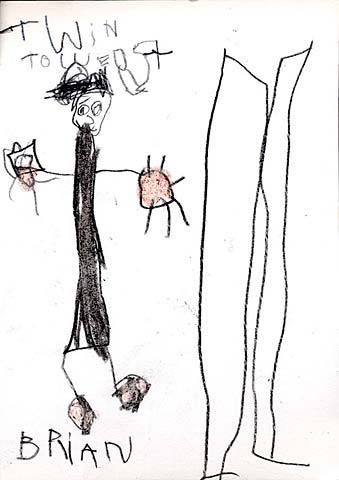
My son gave me the this drawing a while ago depicting the Twin Towers and me with my camera. He was too young to have any memory of 9/11, but much to my amazement he seems acutely aware of the importance of the event, and its importance to me personally.
Here are some more digital pictures of the Haarlemerbuurt (neighborhood around the Haarlemerdijk in Amsterdam) taken last week. Scroll down for earlier pictures.
Amsterdam/Haarlemmerbuurt

The Movies, an art house on the Haarlemerdijk
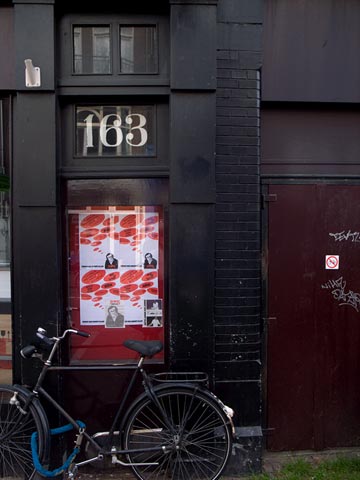
Woody Allen at The Movies on the Haarlemmerdijk
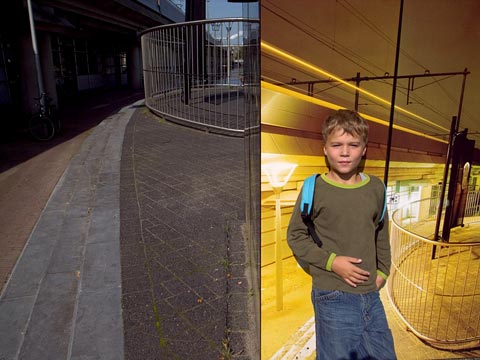
Brendan, my son, Tussen de Bogen
Continuing my walk in the neighborhood around the Haarlemmerdijk in Amsterdam. I photographed my son along the railroad viaduct leading in and out of Central Station. Brendan stands before a night view of the scene behind. It’s a straight shot, not a composite.
Amsterdam/Haarlemmerbuurt

On the bus near Central Station
Walking the Haarlemmerstraat and Haarlemmerdijk one comes across lots of odds and ends in the store windows. Here Elvis makes yet another appearance. Amsterdam is not known for Art Nouveau architecture, but it can be found in various spots around the center of the city. A bit later the Amsterdam School with its organic forms echoed the older style. These two storefronts survived the 20th century relatively intact.

Courtyard just off the Haarlemmerdijk
Urban renewal in the ’70s and ’80s nearly destroyed a number of picturesque neighborhoods in Amsterdam including the Haarlemmerbuurt (see above) and the nearby Jordaan. Dutch planners and technocrats have rarely exhibited great sensitivity to the existing urban fabric, but fortunately they have moved on to, literally, the greener pastures of the polders outside the city. Amsterdam, like other European cities, is blessed and cursed with its now immutable historic heart.
Amsterdam/Haarlemmerbuurt
Today, I walked from Central Station to the Haarlemmerpoort. Once you clear the touristy mess near the station and walk west on the Haarlemmerstraat and Haarlemmerdijk one finds a lively mix of shops, mostly mom and pop operations, and the odds and ends of urban street life. It is, perhaps, Amsterdam’s best street for window shopping, noshing, and capricious purchases. Here are a few pictures. More to follow.

Central Station under construction. A couple of goth kids navigate the strange landscape of modern Amsterdam.
Amsterdam
New York/Amsterdam
I dashed up to the Walker Evans show at the UBS gallery in Midtown just before heading back to Amsterdam. I had just read a review by Michael Kimmelman in the New York Times and was extremely curious to see the new digitally made inkjet prints of familiar Evans images. I was a bit skeptical after reading the article, which was titled “Walker Evans, Or Is It?” The question being whether these new prints, which expand the possible tonal range and detail of the images, changes the intention of Evans’ vision.
Walker Evans at the UBS Art GalleryOnce at the gallery, it didn’t take me long to to come to the conclusion that these prints were the best representation of Evans’ work I had ever seen. In the past, I had never given much thought to the quality of his prints, but just accepted them for what they were–a mixed bag made at different times by different people–especially those prints made from negatives kept at the Library of Congress. Certain kinds of photographic imagery seems to me bound to the specific method of presentation. But Walker Evans was not a printing maven like Ansel Adams, nor one to elevate the objectness of fine printing. His work was about the image, a thing that exists in another dimension–connected, of course, to the print–but ultimately residing elsewhere: in the moment of exposure, in the mind’s eye of the photographer, in the historical and cultural distance of the things and people photographed.
Walker Evans at the UBS Art GalleryThe brochure accompanying the exhibit described the new prints as similar to old music played on modern instruments, and I think there is merit in that analogy. But I would liken it more to the remastering or remixing of recordings of music. It is possible to undermine the original by adding too much digital sheen, too much spatial definition, but it is also possible to enhance the appreciation of the performance by using technology previously unavailable. In the end, the remastered recording can stand side by side with the original, each offering different exeriences of the music. In the case of Walker Evans, the new prints are hung next to earlier prints made or supervised by Evans offering different interpretations of “the images.”
Walker Evans at the UBS Art Gallery, photo-montageProbably the most contentious of the prints in the exhibit is a montage of two pictures Evans made of a road-side scene depicting Black southerners sitting or standing in front of a row of stores. Clearly, Evans made the two photographs with the intention that they be shown next to one another, but actually stitching the two together he never did, and would not have been able to do. Photoshop makes it relatively easy to join overlapping images into one. One is asked to trust the instincts of John Hill and Sven Martson, the printers, who knew Evans before he died in 1975. On a personal note, I was lucky to have attended a slide lecture given by Walker Evans at MICA (the Marlyland Institute College of Art) while I was there in 1974.
New York/Suzanne Vega
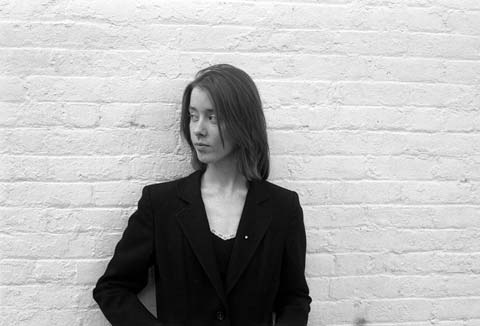
Suzanne Vega, New York, 1980 (35mm film)
I moved to New York in 1977 primarily to study photography at Cooper Union, but I was also a serious songwriter–albeit a beginner–and I quickly found a group of like-minded writers who were meeting weekly to share their latest compositions. It was at one of those meetings at the Cornelia Street Café that I met folk songwriter Jack Hardy, and a couple of years later, Suzanne Vega. The three of us hung out together for several years egging each other on, flinging songs back and forth at each other like weapons, but ultimately believing passionately in one another.
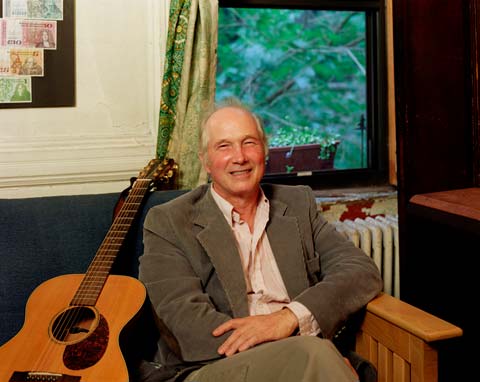
Jack Hardy, New York, 2004 (4×5 film)
During that time I took a lot of photographs, but rarely were any of them of my musician friends. For me, the camera instantly distances and objectifies what is in front of me, and I didn’t want to watch the scene dispassionately, I wanted to belong to it. I know that that is not necessarily the case for other photographers. Think of Nan Goldin, for instance, whose work is part and parcel of the scene she participates in. Suzanne and I talked a lot about looking at the world–I think she has always expressed a certain remove from things, but sharply observed, and with a warmth of spirit that enlivens what might otherwise be icy and disconnected. One of the songs she wrote back then was Tom’s Diner, which she has described as having been written through my eyes.
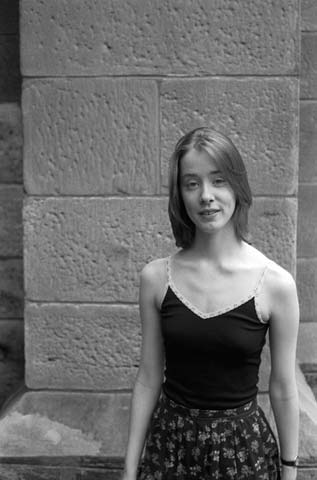
Suzanne Vega, New York, 1980 (35mm film)
When Suzanne first began performing she needed a publicity photo for flyers and posters, and she asked me if I would take some pictures of her. So, I shot two rolls of black and white film. Cost was an issue. We walked around Greenwich Village looking for good locations and backgrounds–a white brick wall, somewhere, worked–and then the gray stones of Grace Church on Broadway and 11th Street. I don’t think they were particularly good PR shots, but Suzanne trusted me, and something comes through in these pictures that is usually missing in the fancier, more self-conscious, photoshoots that followed. Ten years later Suzanne asked me to take some pictures while she was making her Days of Open Hand album. In these photos, taken at the height of her career, it is evident that she knew what to do in front of the camera. But like before we just walked around looking for good spots, chasing the sunlight in her loft in Lower Manhattan.
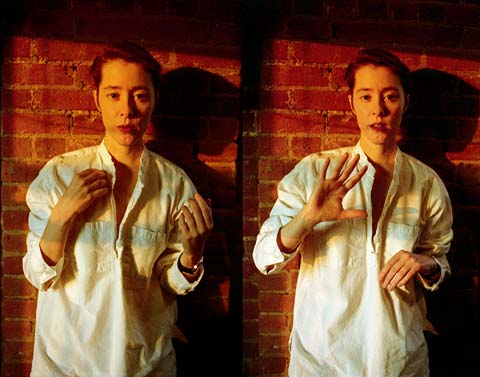
Suzanne Vega, New York, 1990 (35mm film)
I will be doing a small show of these photographs in Olomouc in the Czech Republic this October in conjunction with a film festival. Suzanne and documentary filmmaker Christopher Seufert, who is making a film about her, will be guests.
New York/LES
For all the new enthusiasm for modern architecture evident around town, this is still a city full of dismal brick boxes with small catalogue-ordered windows. A few years ago this one went up on Ludlow and Stanton on the Lower East Side where I am now taking photographs. Gradually, this cheap malproportioned building became a part of the scene in this most sceneful part of New York. A small fashion business rented the storefront, an advertising banner draped the almost blind facade on Ludlow, and grafitti adorned the sides of this wall/building.
I took this picture one recent summer evening as the sun was going down. It was a Friday or Saturday, as I recall, and a red rope was already waiting for patrons of Pianos, a club just to the right of the picture. Red and green, lots of rectangles, ghosting figures, a dog, a bucket, bicycles, dresses, “Chloé.”
New York/Hudson River Park
Since the heat wave of two or three weeks ago, the weather has been mostly beautiful in New York. On one particularly fine day I took a stroll with my family along the Hudson River Park. We walked from City Hall past the WTC site, the newly completed 7 WTC, and the Barclay-Vesey Building on West Street. The latter building is considered the first art deco skyscraper and was designed by Ralph Walker of McKenzie, Voorhees & Gmelin. Completed in 1926, it is a masterpiece of great formal strength, and at the same time, exhibits delicately carved stone work. The vaulted arcades at ground level are, perhaps, what most people know of the building. Despite the immensity of the World Trade Center and Battery Park City complexes nearby, the Barclay-Vesey remained a strong presence on the skyline.
When the WTC towers fell, much damage was done to surrounding buildings including the Barclay-Vesey. It has since been restored to its former glory. Rising next door is the new 7 WTC by David Childs of SOM with its crystalline curtain wall providing an almost transparent glass backdrop to Barclay-Vesey’s brick and stone. I took the picture below with my digital camera just in front of the BPC cinemas where the Goldman Sachs headquarters is under construction. This view will be gone once that skyscraper is completed.
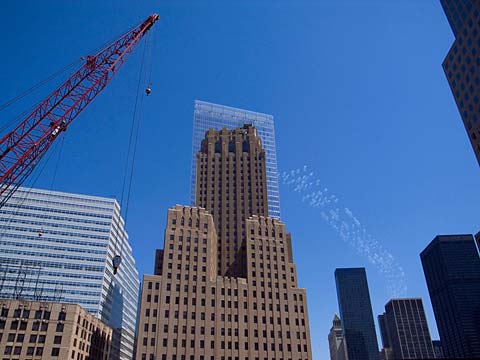
Barclay-Vesey Building and 7 WTC
Further up the river in Chelsea I took a few snapshots of the IAC building designed by Frank Gehry. It is—unbelievably, at this late date–Gehry’s first structure in New York, although many more are now in the pipeline. When the first glass panels of the curtain wall went up, opinions on the blogs and bulletin boards were mixed, to say the least. Some suggested that the smokey white glass was better suited to a suburban office park.
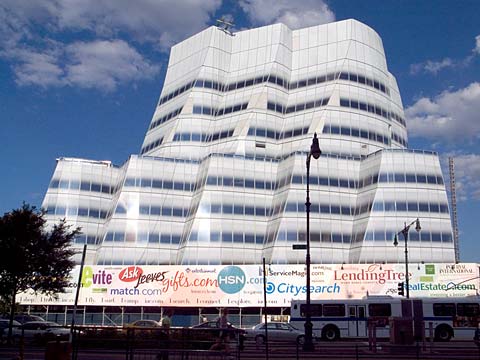
IAC building designed by Frank Gehry
I think the skin of this relatively restrained Gehry building is gorgeous against the pleated armature beneath, looking not unlike a majestic tall ship in full sail on the Hudson River. It will be even better once the street level scaffolding is gone and the glass touches the sidewalk.
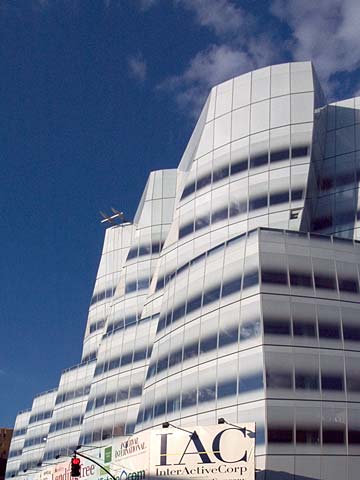
IAC building designed by Frank Gehry
Hudson River Park is still a work-in-progress, but significant stretches of it are finished. On a mild day like this one thousands of people were walking and bicycling the promenade, or sunbathing on the grass. On our way uptown we stopped to rest, and I took this picture of my son Brendan and my wife Renée.
New York/LES
Returned to New York on Friday, and on Saturday got out with the view camera to hit a few spots on the Lower East Side. I had previously noted the view looking toward Katz’s Deli on Houston and Ludlow. Three buildings are going up in close proximity, one occupying a former parking lot, and the other two infill entailing some demolition. There are some very tall structures going up in the neighborhood, undoubtedly using transferred air rights from adjacent properties. Katz’s, of course, is one of the historical monuments of culinary culture on the Lower East Side. “Send a salami to your boy in the army.”

Norfolk Street, Blue and the Switch Building
I walked from there down Norfolk Street to the condo development Blue at Delancey Street. I did a view looking south on Norfolk that included another new apartment building called the Switch Building because of its zig zag window treatment. I took a couple of more photos from the traffic island in Delancey Street showing the Bernard Tschumi tower and the surrounding architectural and commercial cacophany of the neighborhood.

